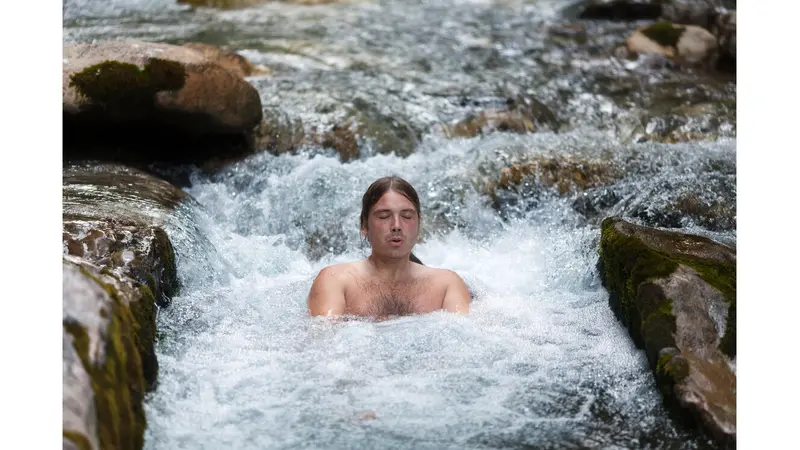
Healing Ways
Healing Ways
Taking the Cold-Therapy Plunge: From Icy Showers to Cryotherapy Chambers
Stress gets a bad reputation, but some forms can be quite beneficial. Hormesis, a self-imposed stress to the body, teaches it to become resilient. Cold therapy is a popular method used by athletes, biohackers and others looking to optimize their performance and physical health.
According to Molly Maloof, a concierge physician, biohacker and consultant to more than 50 companies, there are several types of cold therapy, including a cold shower or cold plunge with 50 to 59 °F water; an ice bath where the water is 41 to 50 °F; and cryotherapy, which exposes the body to extremely cold air (-166 to -220 °F) in a specialized chamber. Maloof notes, “Women may not need as cold a plunge as men because women shiver at higher temperatures and are more sensitive to cold.”
Benefits of Cold Therapy
According to Tom Moorcroft, a board-certified physician specializing in chronic, tick-borne illnesses, “People with chronic inflammatory conditions generally do really well [with cold therapies], both from a perspective of lowering inflammation and dealing with the stress of chronic illness. Patients with chronic, tick-borne infections typically report less pain and inflammation, improved energy and better overall quality of life with even a short 60- to 90-second cold shower daily. A cold plunge three to four times a week improves symptoms even more.”
Maloof notes the following benefits:
- Hormonal Effects: Cold therapy can increase production of norepinephrine and endorphins, which may help alleviate symptoms of depression and anxiety.
- Metabolism and Weight Management: Cold exposure activates brown adipose tissue (BAT), increasing calorie burn. Women typically have more BAT than men, potentially making cold therapy more effective for a metabolic boost.
- Inflammation and Recovery: Cold-water immersion can be beneficial post-exercise to reduce inflammation and muscle soreness. While men’s bodies naturally redirect blood flow after a workout, women’s bodies tend to keep blood in the skin. A cold plunge can help women push that blood back to the muscles, aiding recovery. This benefit may be particularly useful for those experiencing inflammation during certain phases of their menstrual cycle.
- Immune System: Regular cold therapy may strengthen the immune system, and the effects may be more pronounced in men than women due to differences in responses to stimuli.
- Skin Health: Cold therapy, especially plunging the face into a bowl of ice water, can improve skin tone and reduce puffiness by constricting blood vessels.
- Fertility and Reproductive Health: Cold therapy might improve fertility in women by reducing inflammation and balancing hormones, but more studies are needed.
- Cardiovascular Health: Cold exposure can improve cardiovascular health by enhancing circulation. This benefit is important for women, as they have a higher risk of cardiovascular disease after menopause.
Contraindications
Moorcroft states that common side effects of cold therapies include cold skin, temporary dizziness, lightheadedness or headache, an increase in blood pressure and, rarely, frostbite or skin rash. According to both Maloof and Moorcroft, cold therapies are contraindicated for patients with uncontrolled hypertension, an inability to sense the extremities, an allergy to cold, Raynaud’s disease, pregnancy, open wounds, skin infections or recent surgery.
Cold therapy might also be inadvisable for people with eating disorders, as it can exacerbate a disordered metabolism. Cryotherapy is not recommended for those with cardiovascular conditions, stroke history, claustrophobia, severe anxiety disorders, deep vein thrombosis or serious respiratory problems. Cold plunges or ice baths are not recommended for those with epilepsy, diabetes or hypothyroidism.
Tips for Taking the Plunge
Maloof recommends beginning with cool showers and slowly decreasing the temperature for brief periods. Her other recommendations for safely experiencing the benefits of cold therapies include:
- Start cold plunges for short durations of 30 seconds to two minutes.
- Limit cold-water immersion to below the shoulders or neck.
- Keep immersion times to two rounds of 30 seconds with two minutes in-between at the lowest temperatures, and a maximum of six rounds of three minutes with two minutes in-between at the highest immersion temperatures.
- Listen to the body and do not push beyond a level that is comfortable. Remember that women are more sensitive to cold.
- Warm up properly afterward by having warm, dry clothes ready.
- Stay hydrated with water before and after a cold therapy session.
- A cool shower before bed may help with sleep, especially for menopausal women.
“[Cold showers] are more accessible, and more people I work with are likely to start with these than a cold plunge or a cold chamber,” says Moorcroft. “Personally, I prefer a cold plunge by a long shot. It’s a more Zen and focusing experience.”
Madiha Saeed is a holistic, functional and integrative doctor in Naperville, Illinois, and director of education for Documenting Hope and KnoWEwell.
Original article published at Natural Awakenings National


 By
By



